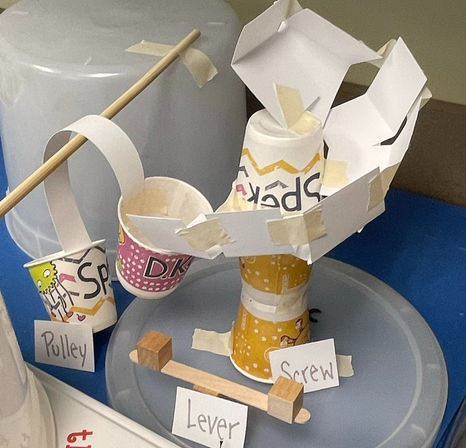Chain Reaction
Objectives:
Students will build each of the 6 simple machines.
Students will create a chain reaction involving at least 3 simple machines.
Next Generation Science Standards Supported:
3-PS2-1. Plan and conduct an investigation to provide evidence of the effects of balanced motion of an object.
3-PS2-2. Make observations and/or measurements of an object's motion to provide evidence that a pattern can be used to predict future motion
Common Core Math Standards Supported:
CC.2.4.3.A.1 Solve problems involving measurement and estimation of temperature, liquid, volume, mass, and length
Materials:
Wooden Balls
Books
String or Yarn
Masking Tape
Wooden Dowels
Small Blocks
Popsicle Sticks
Rubber Bands
Cardstock Paper
Paper Plates
Dixie Cups
6 Simple Machines:
Allow students to observe the pictures (attached) of simple machines. Students will fill out the simple machines organizer with their observations and inferences about each machine.
For a basic explanation of each simple machine and to see them in action, watch this video by PBS. Students will watch this video (or participate in a teacher-guided mini-lesson on simple machines), then attempt to build their own versions of each simple machine with the available materials.
Chain Reaction Challenge:
Ask students to consider how they could combine their simple machines into one big machine. Discuss cause and effect and how one reaction or even can cause another one to start. In order to qualify as a chain reaction machine, there must be no human interference. This means that once the first object is touched/dropped/etc. the rest of machines operate automatically without students touching them, blowing on them, or otherwise interacting with them.
To inspire creativity, allow students to watch this chain reaction video on YouTube. Remind students that their materials are limited so they will not be able to simply recreate what they have seen in the video.
Students should combine at least 3 of the different simple machines into a chain reaction. However, their original plans may not work, and their designs may change throughout the process. If students finish early, encourage them to add in another one or more of their simple machines.
Reflection:
After students have finished their designs, discuss the following as a class (or allow students to complete the attached reflection sheet, which contains the same questions).
- Which simple machine was the easiest to use in your design?
- What was the hardest part of the chain reaction challenge?
- How did your original design change throughout the activity?
- How could you incorporate the more difficult simple machines like levers and screws into your design?
- What else could you create with simple machines?
- Could you use a chain reaction like this to complete an everyday task? How would you design it?




